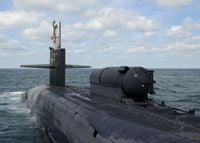In the shadow of mounting global tensions and the ever-present specter of nuclear conflict, two recent developments have thrust the United States’ nuclear preparedness and policy into the spotlight. On one hand, Kathryn Bigelow’s latest film, A House of Dynamite, offers a chilling, dramatized vision of a nuclear missile strike on American soil. On the other, the U.S. military is actively advancing its Sea-Launched Cruise Missile-Nuclear (SLCM-N) program, a controversial deterrence initiative that has prompted fierce debate in Washington and beyond. Together, these stories—one fictional, one all too real—invite the public to reckon with the stakes and complexities of nuclear strategy in the modern age.
Bigelow’s A House of Dynamite, written by Noah Oppenheim and featuring a star-studded cast led by Anthony Ramos, Rebecca Ferguson, and Idris Elba, unfolds in three gripping chapters. The film, which premiered at the 63rd New York Film Festival and is set for a limited theatrical release on October 10, 2025, before heading to Netflix on October 24, doesn’t shy away from the unthinkable: a nuclear missile, launched by an unknown adversary, evades U.S. defenses and obliterates a major city. The loss of millions of lives, though harrowing, is only the beginning. As the narrative progresses, the threat of global nuclear holocaust looms, with government officials racing against time—and their own doubts—to prevent further catastrophe.
The story begins at Fort Greely, Alaska, where Major Daniel Gonzalez (played by Ramos) starts his day with personal frustrations, only to be thrust into crisis as the base’s early warning radar and Ground-Based Midcourse Defense (GMD) system detect an intercontinental ballistic missile (ICBM) streaking in from the Pacific. The initial uncertainty—could it be a test, a malfunction, or a real attack?—rapidly gives way to dread as confirmation arrives: the missile is on a collision course with the continental United States.
Meanwhile, in Washington D.C., Captain Olivia Walker (Ferguson) leaves her family at home, reporting to Admiral Mark Miller (Jason Clarke) in the White House Situation Room. As the primary official in charge, Walker coordinates a video conference with Four Star General Anthony Brody (Tracy Letts), Secretary of Defense Reid Baker (Jared Harris), and Deputy National Security Advisor Jake Baerington (Gabriel Basso), who is caught in traffic with his pregnant wife. The group weighs their options with grim professionalism, but when interception attempts fail, General Brody orders the military’s Defense Readiness Condition to escalate to DEFCON 1—the highest alert level. The President (Elba), attending a charity event, is whisked away for his safety, forced to contemplate the gravest decision imaginable.
According to MovieWeb, the film’s power lies in its meticulous depiction of bureaucratic response and the human toll behind every decision. Manuals and protocols exist for every contingency, but as the film makes clear, no amount of training can prepare officials for the real thing. “None of the characters ever believed this predicament would possibly happen,” the review notes, highlighting the underlying assumption that rational actors would never initiate nuclear war. Yet, as the film suggests, the proliferation of nuclear capabilities and the potential for irrational actors—be they rogue states or terrorist groups—mean that the unthinkable can no longer be dismissed.
One of the movie’s most haunting questions is who gets saved when time is measured in minutes. Essential personnel are rushed to secure bunkers, leaving others behind to face the apocalypse. The film lingers on poignant moments of characters calling loved ones, knowing it may be their last chance. These emotional beats, as well as the shifting perspectives along the chain of command, underscore the high cost of every choice made in the war rooms.
As A House of Dynamite explores the consequences of a failed missile defense and the agonizing uncertainty of retaliation, real-world policymakers are grappling with similar dilemmas. In a recent analysis published by The National Interest, defense journalist Stavros Atlamazoglou delves into the U.S. Navy’s ongoing development of the SLCM-N. First proposed in 2018 under the Trump administration, the program aims to reintroduce a nuclear-capable cruise missile to the Navy’s arsenal, enhancing deterrence against adversaries like Russia and China.
Although the Biden administration sought to cancel the SLCM-N after the 2022 Nuclear Posture Review, Congress has continued to fund research and development. The FY2024 National Defense Authorization Act even mandates that the Pentagon ensure the missile reaches initial operational capability. As of the latest defense budget, the program has received $252 million, with an additional $8 million allocated in June 2025 for technical engineering and facility upgrades. The Navy is now working to modify its submarines to carry the new weapon, though these adjustments could delay deployment.
The SLCM-N is not the Navy’s first foray into sea-launched nuclear cruise missiles. In the 1980s, the service fielded the BGM-109 Tomahawk Land Attack Missile (TLAM-Nuclear), capable of delivering a nuclear warhead over a range of approximately 1,500 miles. However, in 1991, President George H.W. Bush ordered the withdrawal of all sea-based tactical nuclear weapons as part of a post-Cold War drawdown. The TLAM-Nuclear was retired, but the option to rearm submarines with such munitions remained on the table.
Today, the drive to develop the SLCM-N is fueled by concerns that the current U.S. nuclear deterrent—anchored by Trident II D5LE ballistic missiles—may not be sufficient in the face of evolving threats. The Congressional Research Service points out that a key issue in the debate is whether adding the SLCM-N is necessary to “credibly deter limited nuclear use by adversaries and assure allies in Europe and the Asia-Pacific that the United States would protect them from nuclear coercion.”
The Congressional Commission on the Strategic Posture, in a 2023 report, outlined the need for a weapon system that could be forward deployed, survive preemptive attacks, offer a range of explosive yields (including low-yield options), and penetrate adversary air defenses. While the commission did not specifically endorse the SLCM-N, its projected capabilities align closely with these requirements.
The SLCM-N’s supporters argue that it will fill a critical gap in the U.S. deterrence posture, especially as Russia and China modernize their own arsenals. Critics, however, warn of the risks of escalation and the potential for misunderstandings that could lead to disaster. Adjusting Navy submarines to carry the missile also presents technical and logistical challenges that could slow the program’s progress.
Both A House of Dynamite and the SLCM-N program reflect the uneasy reality of nuclear strategy in 2025. As policymakers debate the merits of new deterrence tools and filmmakers dramatize the potential consequences of failure, the world is reminded that the line between fiction and reality can be perilously thin. The stakes have never been higher, and the decisions made today will shape the course of history for generations to come.




